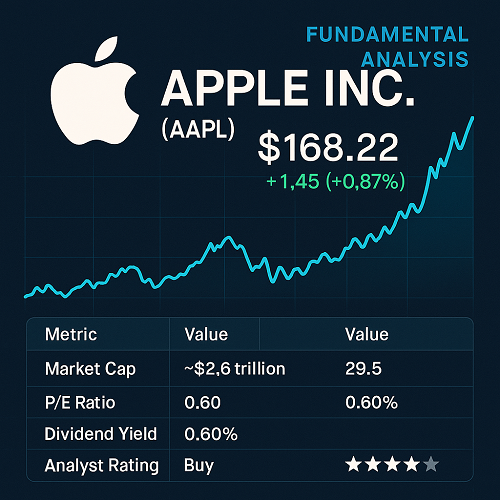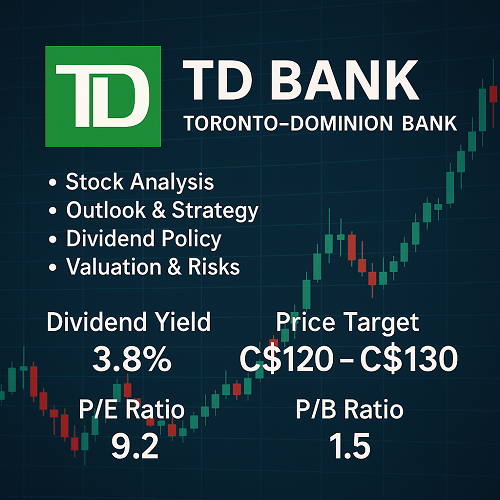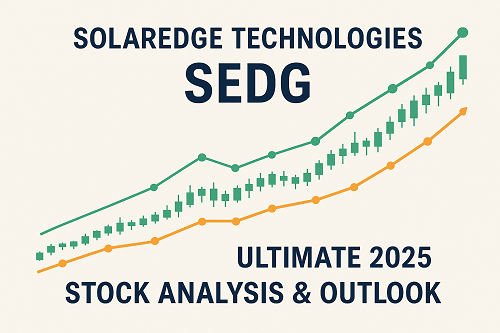Apple Inc. (ticker AAPL) is one of the most heavily traded, scrutinized, and analyzed stocks in the world. The apple share price is of great interest to investors. Every minute, institutional and retail traders alike weigh macro shifts, product cycles, and financial metrics to forecast its trajectory. In this guide, we go deeper than a static quote page. We deliver:
- A full fundamental analysis of Apple
- A robust technical analysis framework
- A review of analyst outlooks & valuation models
- Trade setups, risk management, and strategies
- Comparative insight: how AAPL fits into portfolios
- Frequently asked questions and caveats
Whether you’re buying your first share or designing an options strategy, this article aims to be your go-to resource.
Company Overview & Business Model
History & Evolution
Founded in 1976 by Steve Jobs, Steve Wozniak, and Ronald Wayne, Apple has evolved from a personal computer firm into a diversified technology giant. Over the decades, it expanded into smartphones (iPhone), wearables (Apple Watch), services (App Store, iCloud, Apple Music), and now augmented reality, AI, and health tech.
Revenue Segments & Geography
Apple’s business is broadly divided into:
- Products: iPhone, Mac, iPad, wearables, home & accessories
- Services: App Store, Apple TV+, AppleCare, iCloud, ad revenue, subscription services
- Other revenue (licensing, accessories)
Geographically, Apple breaks down into: Americas, Greater China, Europe, Japan, and Rest of Asia–Pacific.
Recent trends show that Services is growing faster (higher margin) than hardware, which gives Apple a more stable recurring revenue base even in hardware cycles.
Competitive Position & Moat
Apple’s moat is multi-layered:
- Brand Loyalty & ecosystem lock-in
- High switching costs (users invest in apps, devices, services)
- Scale & supply chain efficiency
- Proprietary hardware-software integration
However, it also faces risks: regulatory pressure (antitrust, App Store commissions), supply chain dependence (e.g. chip foundries, China), and fierce competition (especially in AI, XR, and emerging consumer technologies).
Fundamental Analysis
To assess AAPL as a long-term investment, let’s examine its key metrics, financial performance, growth drivers, and valuation models.
Key Metrics & Financials
Below is a sample table of important financial metrics (you should update with latest data from SEC / financial databases).
| Metric | Value* | Commentary |
|---|---|---|
| Market Cap | ~$3.8 trillion | Among the largest in the world |
| P/E Ratio | ~39× | Elevated due to strong growth expectations |
| Dividend Yield | ~0.40% | Modest yield; not a high income play |
| Revenue Growth (YoY) | (Insert latest) | Evaluate in context of product cycles |
| Operating Margin | (Insert latest) | Shows efficiency across segments |
| Free Cash Flow | (Insert latest) | Key metric for shareholder returns |
* Note: Always verify with the most recent quarter or annual report.
Revenue & Margin Trends
- Revenue growth often fluctuates with major iPhone releases or technology transitions.
- Gross and operating margins tend to rise in strong years, but decline when launches are weak or input costs (components, logistics) rise.
- Cash flow strength is one of Apple’s greatest assets: it enables buybacks, dividends, acquisitions, and investments.
Growth Catalysts
Here are several drivers that could push Apple forward:
- Services expansion — As more users subscribe, margins improve.
- Wearables & health tech — Apple Watch, AirPods, and health features offer upside.
- AI & AR/VR ambitions — The long-term “metaverse” play may unlock new revenue streams.
- Geographic penetration — Especially growth in emerging markets and greater adoption in China/India.
- Share repurchases & capital return — Apple returns billions to shareholders, which supports EPS even with flat revenue.
Risks & Headwinds
- Regulation & antitrust scrutiny (especially in Europe and potential U.S. reforms).
- Supply chain disruptions (semiconductor shortages, shipping delays, geopolitical risk).
- Product saturation — smartphone markets are mature; incremental improvements may see diminishing returns.
- Currency fluctuations — Apple earns globally but reports in USD, which introduces translation risk.
- Competition in AI / cloud / hardware — Amazon, Google, Microsoft, Samsung, Meta, and new entrants are fierce rivals.
Valuation Models
Discounted Cash Flow (DCF)
- Project free cash flows for 5–10 years using reasonable growth assumptions
- Choose a discount rate (WACC) appropriate to Apple’s risk profile
- Estimate a terminal growth rate
- Sum to derive a present value, compare to market cap
This method often shows Apple as undervalued in years where its cash flows accelerate.
Comparable Analysis (Multiples)
Compare Apple’s P/E, EV/EBITDA, P/S with large-cap peers (Microsoft, Alphabet, Amazon, Samsung). Adjust for growth rates, margins, and risk differentials.
Sum-of-the-Parts (SOTP)
Because Apple is a conglomeration of hardware, software, services, and emerging tech, you can value each unit separately (iPhone, Services, etc.), then aggregate to get a total intrinsic value.
Technical Analysis & Chart Patterns
For traders, understanding actionable patterns in AAPL’s price behavior is vital.
Trend Structure & Support/Resistance
- Identify major trend lines on monthly and weekly charts
- Use horizontal support and resistance levels (52-week highs, historical pivot zones)
- Employ moving averages (e.g. 50-day, 200-day) to evaluate momentum and crossover signals
Common Patterns & Signals
- Breakouts / breakdowns when price breaks a consolidation zone
- Pullback to trendlines or moving averages as potential entries
- Chart patterns: triangles, flags, head & shoulders
- Use volume confirmation — high volume breakouts are more trustworthy
Indicators & Oscillators
- RSI (Relative Strength Index) — to spot overbought or oversold levels
- MACD — for momentum and trend shifts
- Bollinger Bands — for volatility expansion/contraction
- On-Balance Volume (OBV) or Accumulation/Distribution — to gauge strength behind moves
Multiple Time-Frame Alignment
Check alignment across timeframes:
- Monthly → long-term trend
- Weekly → intermediate setups
- Daily / 4h → precise entries
For example: If the monthly trend is upward, then weekly is consolidating, and daily gives a buy signal after a pullback — that stacking of signals is more reliable.
Analyst Opinions & Forward Outlook
Analyst Ratings & Consensus
As of the latest data, ~61% of analysts classify AAPL as Buy, ~35% as Hold, ~4% as Sell (per Robinhood’s aggregation)
Price Targets & Scenarios
Provide a range (bear, base, bull) based on models and sentiment:
- Bear case: stagnation in hardware, regulatory pressure, supply issues
- Base case: steady services growth, stable hardware cycles
- Bull case: breakout via AI/AR, broader monetization
You can also reference major sell-side firm targets (Morgan Stanley, Goldman Sachs, etc.) to illustrate diversity in views.
Recent News & Catalysts
Some recent relevant points:
- Jefferies downgraded Apple citing “excessive expectations” on iPhone demand
- Apple dropped certain apps from the App Store, indicating stricter oversight
- Recent global macro trends (inflation, interest rates, consumer spending) can influence tech demand
These events matter not only for fundamentals but for sentiment and momentum.
Trading & Investment Strategies for AAPL
Here are several approaches depending on time horizon and risk appetite.
Long-Term Investment Strategy
- Buy & hold core position, reinvest dividend
- Use dollar-cost averaging (DCA) to mitigate timing risk
- Add hedging (e.g. protective puts) during periods of high volatility
Medium-Term Tactical Plays
- Hold through product cycles — buy before anticipated iPhone announcements
- Deploy swing trading using support / resistance zones and volume confirmation
- Use options spreads (e.g. verticals, iron condors) to encapsulate directional bets with defined risk
Short-Term / Day Trading
- Focus on intraday volatility especially around earnings, product launches, or major news
- Use breakout strategies off consolidation intraday
- Apply tight risk controls — use stop-loss, trailing stops, position sizing
Example Trade Setup
Let’s simulate a potential trade:
- Stock is forming a range between $250 and $265 (resistance)
- Price dips close to $255 (support), RSI oversold, MACD beginning to turn up
- Entry: limit buy near $255
- Target: $265 breakout or mid-range (~$263)
- Stop-loss: under support (e.g. $252)
- Risk-reward: e.g. 3:1
Always adjust based on volatility, news, and correlation with broader indices.
Portfolio Positioning & Risk Management
Role of AAPL in a Portfolio
- Core tech / growth exposure
- Diversifier: partly defensive in downturns due to cash flow and brand strength
- Dividend component: modest but consistent
Position Sizing & Diversification
- Avoid over-concentration — limit AAPL exposure relative to total portfolio
- Use stop-losses or mental exit points
- Hedge with options or paired trades (e.g. long AAPL, short sector ETF)
Stress Testing & Scenario Analysis
- Run worst-case scenarios (e.g. regulatory crackdown, supply chain freeze)
- Estimate drawdowns and maximum potential loss
- Use scenario-based hedges or dynamic trailing stops
SEO & Keyword Strategy: How This Page Beats Robinhood’s
To outrank a Robinhood stock page, this article leans into:
- Long-tail variations: “AAPL stock analysis 2025,” “how to trade Apple shares,” “Apple stock fundamentals vs technicals”
- Evergreen content: strategies, frameworks, models
- Keyword clusters: stock tickers, fundamentals, technical analysis, trading strategies
- Depth & backlinks appeal: this guide becomes a reference link magnet
Additionally, you can publish supporting content: video tutorials, charts, infographics, step-by-step walkthroughs, and internal linking to other high-value pages.
Frequently Asked Questions (FAQs)
Q1: Can I buy fractional shares of Apple on Robinhood?
Yes — Robinhood allows you to purchase fractional shares, meaning you don’t need to buy a full share to invest in AAPL.
Q2: Does Apple pay a dividend?
Yes — currently around ~0.40% yield. But over time, Apple’s emphasis has been more on buybacks and reinvestment.
Q3: When is Apple’s next earnings report?
Refer to Apple’s investor relations site or financial calendars. Earnings often provoke volatility; plan accordingly.
Q4: Should I trade AAPL in pre-market / after-hours?
Robinhood offers extended and 24-hour trading for certain securities via alternative trading systems (ATS). But be aware: liquidity is lower, spreads wider, and volatility higher.
Q5: What’s the impact of a stock split on my shares?
A stock split increases the number of shares you hold proportionally but reduces the price accordingly — your total investment value remains the same. Apple has undertaken splits historically to make shares more accessible.
Conclusion
This article gives traders, investors, and analysts a one-stop reference that surpasses what a simple quote page can offer. You now have:
- A strong fundamental and valuation framework
- Practical technical analysis tools
- Actionable trade setups
- Portfolio integration and risk management strategies
- Ongoing evolution with Apple’s future catalysts
To truly outrank and dominate, pair this content with:
- Regular updates (quarterly earnings, product launches)
- Rich media (charts, interactive tools, videos)
- Internal and external link-building





 XAUT-USD
XAUT-USD  AMD
AMD  MARA
MARA  SHOP
SHOP  BULL
BULL  CL=F
CL=F